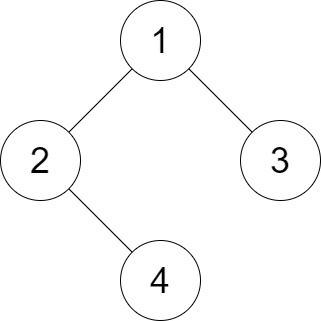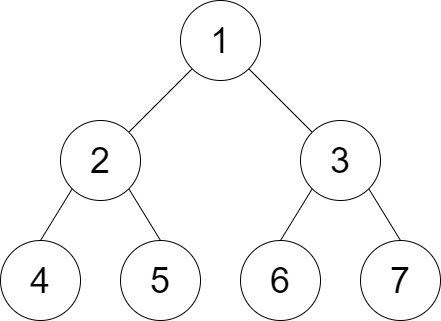1530. 好叶子节点对的数量 #
Difficulty: 中等
给你二叉树的根节点 root 和一个整数 distance 。
如果二叉树中两个 叶 节点之间的 最短路径长度 小于或者等于 distance ,那它们就可以构成一组 好叶子节点对 。
返回树中 好叶子节点对的数量 。
示例 1:

输入:root = [1,2,3,null,4], distance = 3
输出:1
解释:树的叶节点是 3 和 4 ,它们之间的最短路径的长度是 3 。这是唯一的好叶子节点对。
示例 2:

输入:root = [1,2,3,4,5,6,7], distance = 3
输出:2
解释:好叶子节点对为 [4,5] 和 [6,7] ,最短路径长度都是 2 。但是叶子节点对 [4,6] 不满足要求,因为它们之间的最短路径长度为 4 。
示例 3:
输入:root = [7,1,4,6,null,5,3,null,null,null,null,null,2], distance = 3
输出:1
解释:唯一的好叶子节点对是 [2,5] 。
示例 4:
输入:root = [100], distance = 1
输出:0
示例 5:
输入:root = [1,1,1], distance = 2
输出:1
提示:
tree的节点数在[1, 2^10]范围内。- 每个节点的值都在
[1, 100]之间。 1 <= distance <= 10
题解 #
解法一:递归解法 #
/**
* Definition for a binary tree node.
* public class TreeNode {
* int val;
* TreeNode left;
* TreeNode right;
* TreeNode() {}
* TreeNode(int val) { this.val = val; }
* TreeNode(int val, TreeNode left, TreeNode right) {
* this.val = val;
* this.left = left;
* this.right = right;
* }
* }
*/
class Solution {
public int countPairs(TreeNode root, int distance) {
Pair pair = dfs(root, distance);
return pair.count;
}
// 对于 dfs(root,distance),同时返回:
// 1)每个叶子节点与 root 之间的距离
// 2) 以 root 为根节点的子树中好叶子节点对的数量
public Pair dfs(TreeNode root, int distance) {
int[] depths = new int[distance + 1];
boolean isLeaf = root.left == null && root.right == null;
if (isLeaf) {
depths[0] = 1;
return new Pair(depths, 0);
}
int[] leftDepths = new int[distance + 1];
int[] rightDepths = new int[distance + 1];
int leftCount = 0, rightCount = 0;
if (root.left != null) {
Pair leftPair = dfs(root.left, distance);
leftDepths = leftPair.depths;
leftCount = leftPair.count;
}
if (root.right != null) {
Pair rightPair = dfs(root.right, distance);
rightDepths = rightPair.depths;
rightCount = rightPair.count;
}
for (int i = 0; i < distance; i++) {
depths[i + 1] += leftDepths[i];
depths[i + 1] += rightDepths[i];
}
int cnt = 0;
for (int i = 0; i <= distance; i++) {
for (int j = 0; j + i + 2 <= distance; j++) {
cnt += leftDepths[i] * rightDepths[j];
}
}
return new Pair(depths, cnt + leftCount + rightCount);
}
}
class Pair {
int[] depths;
int count;
public Pair(int[] depths, int count) {
this.depths = depths;
this.count = count;
}
}